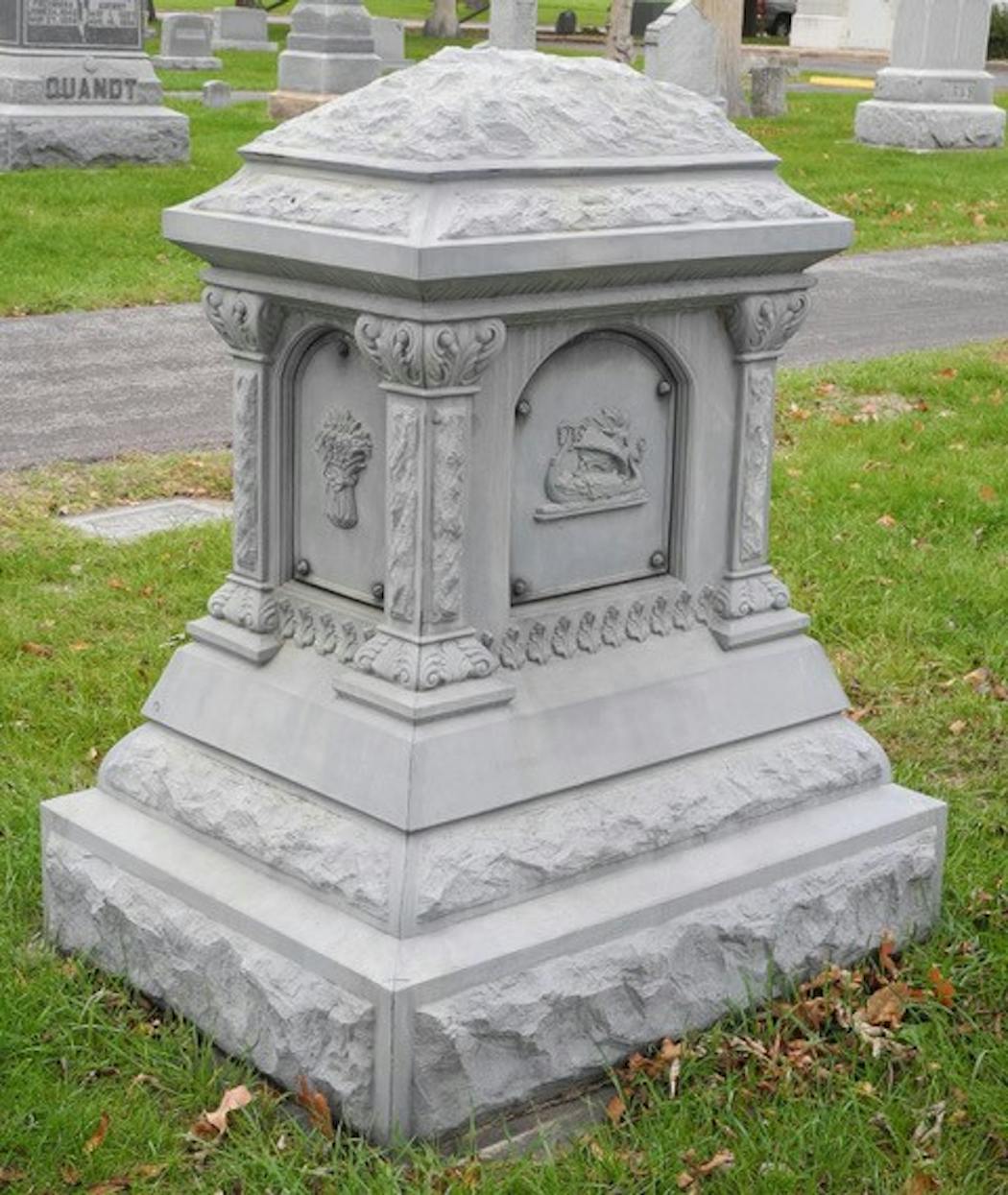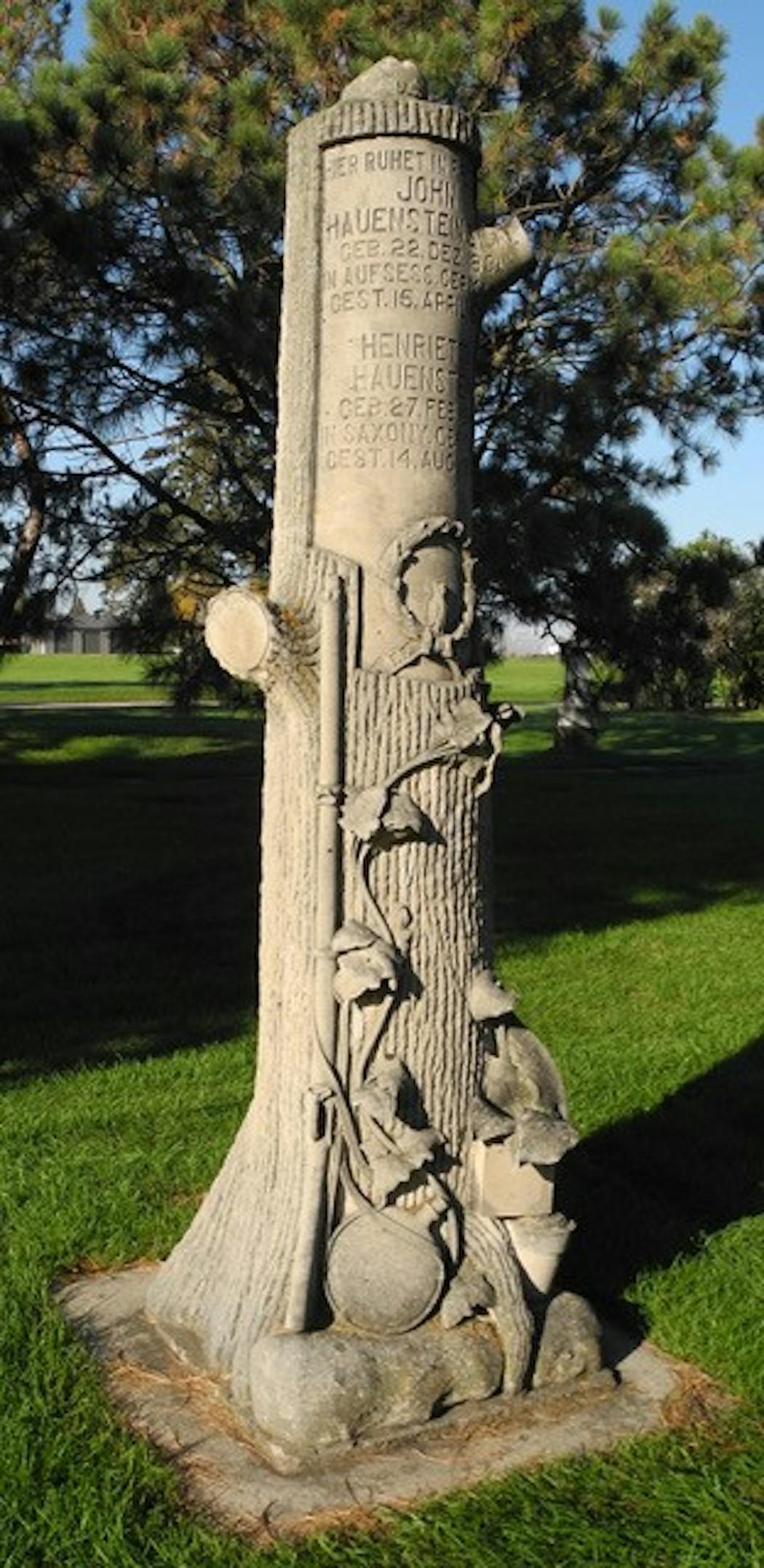Elroy Ubl loves the symbolism punctuating the sprawling cemeteries about a mile north of his longtime hometown of New Ulm.
Take the 15-foot, 3-ton limestone tree stump that marks the grave of brewer August Schell and his wife, Theresa, who emigrated from Germany to Cincinnati in the mid-1800s, married and moved to New Ulm.
Ubl points to the jagged top of the hand-carved monument, symbolizing how Schell's life was abruptly cut short at age 63 in 1891. The carved ivy vines spiraling up the trunk, he says, represent memories, friendships and eternal life. The open book on the trunk, noting the places and dates they were born and died, represents the Book of Life.
"You can't miss it — it sticks out like a sore thumb," said Ubl, 82, a retired science teacher and nursing home administrator who's a longtime history buff and has led many cemetery tours.
Ubl has just self-published his eighth book on local history, "New Ulm's 'Outdoor Museum,'" which details 29 distinctive tree stump markers and nine so-called white bronze markers in New Ulm's City, Catholic and Lutheran cemeteries.
"White bronze is a misnomer: They're 99 percent zinc — but white bronze sounded more appealing," Ubl said. "They look massive and solid like granite, but when you tap your knuckles on the surface, you can tell the zinc panels are hollow."
Marketed as a durable alternative for graves, zinc markers were made from 1874 to 1914 by the Monumental Bronze Co. of Bridgeport, Conn. The company quit producing them when World War I broke out, reserving zinc for gun mounts and munitions.
"There are several stories passed down about how, during Prohibition, people would hide alcohol in the hollow panels for night visits to the cemetery," Ubl said. "The panel covers could be easily removed and then put back — an ideal hiding place for illegal contraband."
In Lot 450 of the Old Section, you'll find a great example of the zinc monuments. German and Barbara Friton, German immigrants who married in New Ulm in 1864, are buried beneath a sarcophagus-style monument loaded with symbolism — including a "last voyage" motif depicting an angel guiding the dead to the afterlife. An anchor on the marker's side panel represents hope and stability.
Ubl said the Schells' grave marker, at Lot 78 in the cemetery's Pioneer Section, is among his favorites. His keen eye discovered the name of Italian immigrant Anthony Ambrosini of St. Paul carved into the limestone marker, which likely came pre-carved from the Indiana quarries before Ambrosini engraved more details on it.
"When the limestone was first quarried, it contained a lot of moisture and was considered 'green' and soft for carving," Ubl explained. "A mistake could be easily shaved off if the limestone was still green. But as it weathers, the limestone becomes hardened."
More than 2,000 tree stump monuments have been documented coming from the Indiana quarries between 1880 and 1935, but a study showed that only 3% included a carver's initials or name. So it was a bit of a coup for Ubl to find Ambrosini's name tucked into a mock log supporting the open-book epitaph on the Schells' marker.
Census records show Ambrosini emigrating from Italy as a 12-year-old in 1874, and working in 1910 as superintendent of what is now Forest Lawn Cemetery in Maplewood. He lived nearby in New Canada Township — later known as Little Canada.
Some of the tree-stump memorials have additional features. There's an empty chair next to the Schell monument, symbolizing the loss of a loved one. The grave of another New Ulm brewer, John Hauenstein, is marked by a limestone tree stump that includes carvings of an old rifle, canteen and book, and a military cap reflecting his service with the First Minnesota Mounted Rangers.
A favorite Ubl memorial is an 8-foot double tree stump marking the graves of pioneer farmer Peter Fesenmaier, who died in 1939, and his wife, Katherine, who had died 16 years earlier following gallstone surgery.
"The double tree stump symbolizes how they were joined together — two lives joined as one," Ubl said.
If you're like me and find cemeteries fascinating, I'd be tempted to grab a copy of Ubl's book and make a trek to New Ulm to check out the tree stump and white bronze monuments. The book is chock-full of his own color photos, graveyard maps, newspaper clippings and biographical sketches of those buried beneath the limestone and zinc. You can pick it up at the Brown County Historical Society in New Ulm for $25, or you can shoot an email to Ubl at history@newulmtel.net and he'll send you a copy for $30, including $5 for shipping.
Curt Brown's tales about Minnesota's history appear every other Sunday. Readers can send him ideas and suggestions at mnhistory@startribune.com. His latest book looks at 1918 Minnesota, when flu, war and fires converged: strib.mn/MN1918.

Civil War group honors the last Union veteran buried in each Minnesota county

St. Cloud professor's book paints nuanced look at enslaved woman freed in Minneapolis

Paying overdue tribute to his grandmother, a Minnesota farmer recarves family history

Civil War officer brought formerly enslaved family to Minnesota





